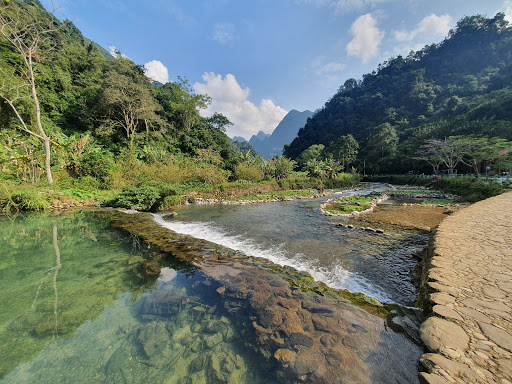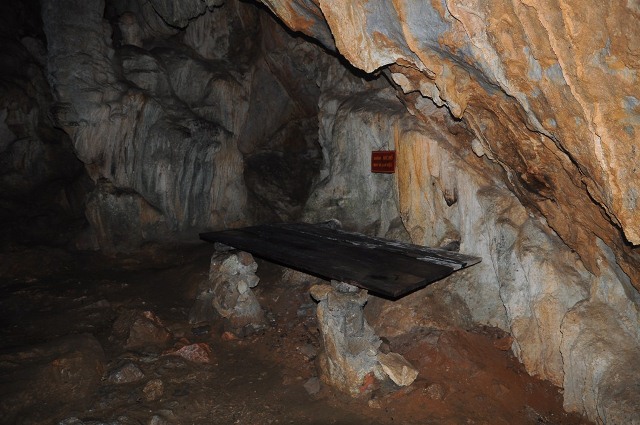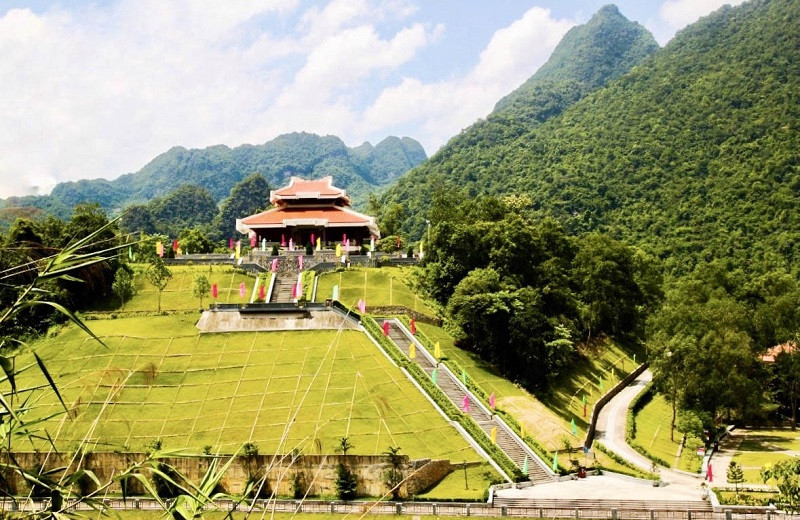Pac Bo

Pac Bo is a remote cave complex nestled in the rugged mountains of Cao Bang Province in Vietnam. It is renowned for being the place where Ho Chi Minh, also known as Uncle Ho, lived and organized resistance against colonial and imperial forces during the mid-20th century.
Pac Bo historical relic complex is located in Truong Ha commune, Ha Quang district, Cao Bang province. According to the Tay-Nung ethnic language, the name Pac Bo means "the source." This is the place where President Ho Chi Minh chose as the revolutionary headquarters and held significant importance in the resistance against French and American colonial forces.
Through several important milestones over the years, this place still preserves nearly intact the evidence and imprints of the revolution and of President Ho Chi Minh. Cao Bang's Pac Bo is surrounded by rugged mountain ranges, cascading waterfalls beckoning with their splendor, and lush bamboo groves as far as the eye can see. In addition to the beautiful natural scenery, visitors can also explore historical landmarks such as the Le Nin Spring, Mac Mountain, Ho Chi Minh Memorial Monument, and Pac Bo Cave.

The clear turquoise water of Le Nin stream
If you want to fully appreciate the beauty of this place, travelers should choose to visit between October and May. During this time, the weather is pleasantly mild, not too cold, and not too hot, with dry conditions that are conducive to traveling the rugged mountainous terrain of Pac Bo. What's especially noteworthy is the opportunity to admire the enchanting beauty of the Le Nin stream. Le Nin stream is renowned for its mesmerizing emerald-green waters, but there are about 2-3 months of the rainy season (from July to September), during which the water flows turbulently, and the water surface won't appear as clear.
Le Nin Stream
Le Nin Spring, formerly known as Khuoi Giang Spring, which means 'heavenly spring' in the Tay language, underwent a name change in 1941 when President Ho Chi Minh returned to Vietnam and chose to live and work in Pac Bo Cave. He renamed it Le Nin Spring. Le Nin Spring is renowned for its crystal-clear, emerald waters that allow you to see the bottom, combined with the lush greenery surrounding it, creating a picturesque landscape. This destination is beloved by many for its tranquil atmosphere and romantic, idyllic scenery.

Le Nin stream
Visitors to this place will feel the connection to the time when President Ho Chi Minh once lived here, almost sensing his presence, and witnessing the landscapes that he was closely associated with during the resistance against colonial forces.
Cac Mac Mountain
Along with Le Nin Stream, Cac Mac Mountain was also named by President Ho Chi Minh. These are the names of two influential thinkers who greatly influenced Uncle Ho's revolutionary activities. Cac Mac mountain features dense, green forests with an open landscape inside, but it's treacherous terrain, perhaps the reason Uncle Ho chose it as a place for secretive activities. Near Cac Mac mountain, following Le Nin Stream, travelers will come across a bamboo garden that Uncle Ho planted, which still exists today.

Le Nin Stream and Cac Mac Mountain located near each other
Pac Bo Cave
Coc Bo Cave, also known as Pac Bo Cave, has an area of approximately 15 square meters. It is the place where Ho Chi Minh resided and worked when he first returned to Vietnam, and it holds many significant traces of his time there. Inside the cave, there is a wooden bed where Uncle Ho rested, a fireplace for warmth, a stone table where he worked, and a rock by which he would sit to fish by the Le Nin stream.

Inside Pac Bo Cave

President Ho Chi Minh's bed in the cave
Temple of President Ho Chi Minh
When visiting the historical site of Pac Bo, don't forget to pay a visit to Ho Chi Minh's temple located on Tieng Chay Hill. The temple was constructed in May 2011 to commemorate the 121st anniversary of his birth. It was built in the familiar and cozy stilt house style of the local ethnic people in this area.

The temple of President Ho Chi Minh
Khuoi Nam Shack
Khuoi Nam Shack is about 1 km away from Pac Bo Cave, and it's the place where Uncle Ho resided the longest during his time in Pac Bo, Cao Bang. The road to Khuoi Nam Shack is quite steep and winding, especially at the foot of the mountain, but it has now been renovated with stone paving for easier access. Khuoi Nam Shack is relatively small, measuring only about 12 square meters, and it is built in a simple and rustic style, resembling a traditional stilt house.

This is the place where Uncle Ho lived the longest in Pac Bo
Ticket prices for visiting Pac Bo are as follows:
- Adult ticket: 20,000 VND per ticket.
- Children over 10 years old: 15,000 VND per ticket.
- Children under 10 years old: Free admission.
In conclusion, visitors to Pac Bo in Cao Bang will have the opportunity to admire the remaining historical traces and gain insights into the significance of the historical relics here. The terrain in this area is quite suitable for those who enjoy outdoor activities.
Explore exceptional natural landscapes on an unforgettable day with our exciting...